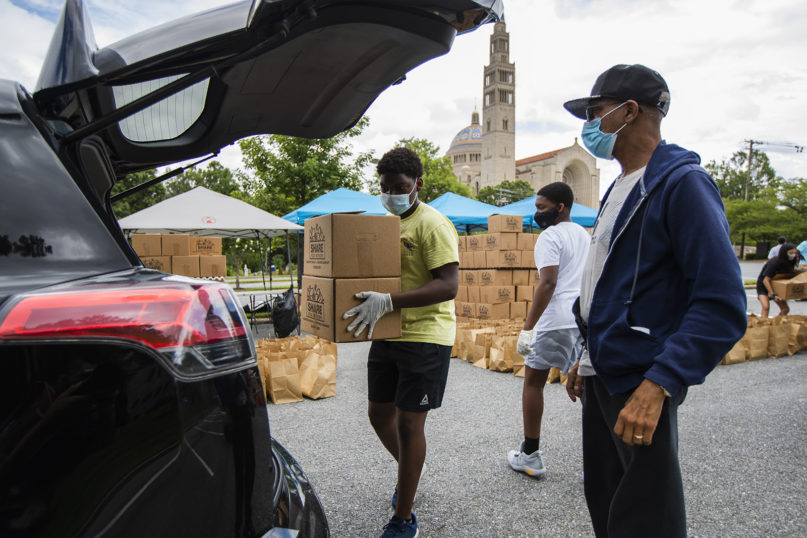(RNS) — Like many other non-profits, a good number of Catholic organizations have been hit hard during the pandemic.
More than 100 Catholic schools have said they will be forced to close and many more than that are in serious trouble. Parishes, especially those in poor neighborhoods, are hanging by a thread without their weekly collection plate donations. Several liberal arts Catholic colleges, already on the brink, will be pushed into closure if they cannot safely open with in-person classes in the fall.
This is not even taking into account the way the pandemic has strained local hospitals, nursing homes and food banks run by employees of the Catholic Church.
Yet in the Associated Press’ recent investigation into money loaned to Catholic organizations through the federal Paycheck Protection Program, the AP’s headline lumped all these locally oriented entities and often poorly funded institutions together as “the Catholic church,” and implies that highly placed prelates engineered a payoff to counter expenses far afield from paying local workers.
While acknowledging that religious groups of all stripes “persuaded the Trump administration to free them from a rule that typically disqualifies an applicant with more than 500 workers,” the AP’s story strangely chose to focus exclusively on Catholic entities. Other outlets, such as the Detroit Free Press, reported on the topic by noting that “Michigan churches, synagogues, mosques get millions in federal PPP loans.”
In addition, the AP story makes much of the fact that some archdioceses face significant financial settlements for the victims of sexual abuse. But the PPP funds, most of which must be spent within a short timeframe on workers’ salaries, distributed across some 9,000 individual offices, schools and other organizations, won’t spare the church the economic pain of these settlements.
The AP report notes that PPP loans to Catholic organizations saved at least 407,900 jobs. As the Catholic News Association pointed out, a high-end estimate of the cost for each job saved would be $8,580. An incredible bargain.
And the goal of the PPP was, after all, to protect the paychecks of workers. Unless one arbitrarily claims that parish receptionists, food bank directors and sixth-grade gym teachers’ jobs aren’t worth protecting because the institutions they work for are affiliated with the Catholic Church, it is clearly a very good thing Catholic institutions were included in the PPP program.
Yet AP’s story described Catholic institutions’ use of paycheck protection loans as “cashing in.” The Rev. James Martin pointed out in America magazine that such language paints a false picture of what happened. “Which employees should these parishes, schools and social service agencies have laid off rather than accepting these government funds?” Martin asked.
In response to the AP’s story, the U.S. Conference of Catholic Bishops wrote in a statement, “The Catholic Church is the largest non-governmental supplier of social services in the United States. Each year, our parishes, schools and ministries serve millions of people in need, regardless of race, ethnicity or religion. The novel coronavirus only intensified the needs of the people we serve and the demand for our ministries.”
Consider the particular example of St. Thomas More Academy, which serves a poor neighborhood in Washington, D.C. Their 32-year-old principal, Gerald Smith Jr., notes that his school is a lifeline, beacon of hope and a home. During the pandemic, the school has provided Chrome books, online learning software and food for its needy students. If Thomas More hadn’t received PPP support, yet another Catholic school would have closed and even more vulnerable students would have lost a lifeline to their futures.
In terms of the overall impact of Catholic organizations, Catholic Charities USA is, all by itself, a top-five U.S. charity with more than 240,000 staff, volunteers and board members. It served 13 million people of all faiths in 2019 through local offices and has been particularly active during the past few months.
Catholic Charities in Newark, New Jersey, for instance, used its PPP funds to keep all of its staff working during the pandemic — including in homeless shelters, nursing homes and mental health clinics.
Catholic Charities of Galveston-Houston, in addition to its normal food distribution schedule, upped its game during the first two weeks of the pandemic by giving out a whopping 79,000 pounds of food to nearly 9,000 needy people using drive-through distribution. Similar stories of service can be told about local Catholic Charities offices around the country.
The real story surrounding the Catholic Church’s PPP loans is not just how many workers’ livelihoods were saved by these funds, but how essential these workers have been during the pandemic.
Depriving vulnerable populations of their ministry would have been a catastrophic loss for the country.
(This article has been updated in paragraph 12 to reflect that Catholic Charities helped 13 million people in 2019.)






